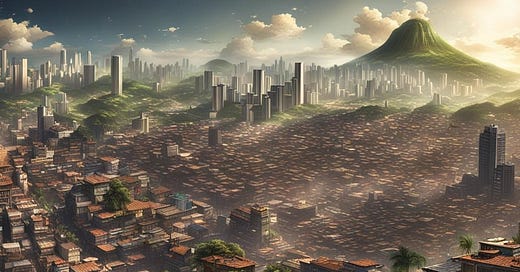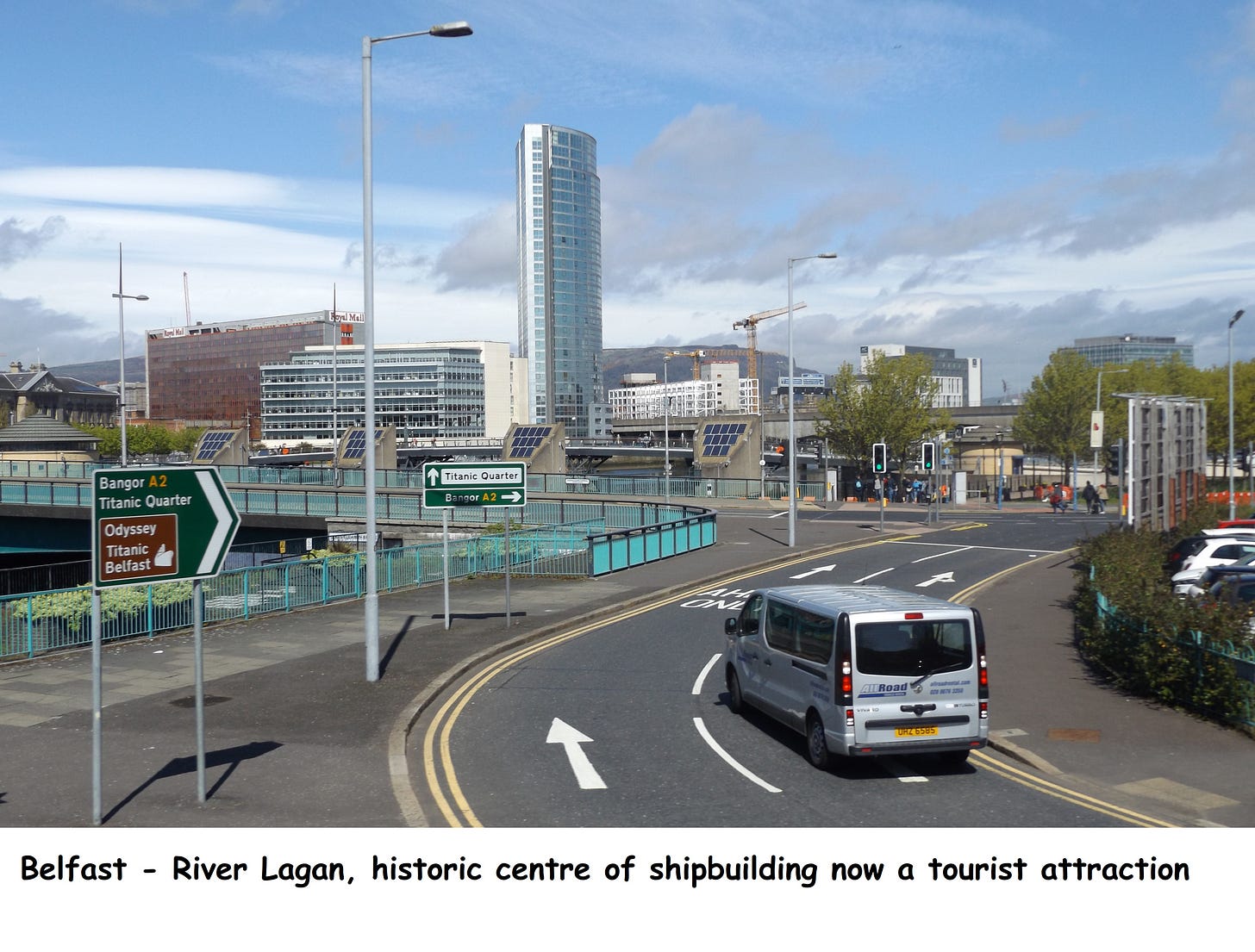Urbanisation in developed and developing countries can differ significantly due to variations in economic, social, and historical contexts. Here, I'll explore some key differences between urbanisation in these two types of countries.
Pace and Scale: In developing countries, urbanisation often occurs at a rapid pace, driven by factors such as population growth, rural-urban migration, and industrialisation. Mega-cities with populations exceeding ten million inhabitants are more common in developing countries. On the other hand, developed countries typically experience a slower rate of urbanisation, as their populations are already predominantly urbanised, and growth tends to be focused on urban renewal and revitalisation rather than new city formation.
Informal Settlements: Developing countries often face challenges related to informal settlements, also known as slums or shantytowns. These settlements are characterised by inadequate housing, limited access to basic services like clean water and sanitation, and a lack of formal property rights. The rapid influx of rural migrants to cities in developing countries often leads to the spontaneous formation of these settlements due to a lack of affordable housing options and limited urban planning. In contrast, developed countries generally have more regulated housing markets and stricter urban planning policies, resulting in a lower prevalence of informal settlements.
Infrastructure and Services: Developed countries typically have well-developed infrastructure systems, including reliable transportation networks, advanced healthcare facilities, and efficient public services. Urban areas in these countries benefit from well-maintained roads, public transportation systems, and access to high-quality education and healthcare services. In contrast, developing countries often struggle to provide adequate infrastructure and services to their growing urban populations. Issues like inadequate transportation systems, poor sanitation, and limited access to healthcare and education can hinder the quality of life for urban residents in developing countries.
Economic Development and Employment Opportunities: Urbanisation in developed countries is often accompanied by a shift from traditional manufacturing industries to service-based economies. Urban centres in developed countries offer a wide range of employment opportunities in sectors such as finance, technology, healthcare, and professional services. In developing countries, urbanisation is often driven by industrialisation and the growth of manufacturing sectors. Cities in these countries may experience a concentration of factories and industrial zones, providing employment opportunities for the rural migrant population.
Environmental Impact: Urbanisation in both developed and developing countries has environmental consequences, but the nature and scale of these impacts can differ. In developed countries, there is often a greater emphasis on sustainable urban planning and environmental regulations, leading to the implementation of eco-friendly infrastructure, green building practices, and waste management systems. Developing countries may face challenges in managing the environmental impact of rapid urbanisation, including increased pollution levels, deforestation, and strain on natural resources.
Governance and Planning: Developed countries typically have well-established governance structures, urban planning departments, and regulatory frameworks to guide urban development. Planning processes involve multiple stakeholders and prioritise factors like sustainability, public participation, and long-term urban management. In contrast, developing countries may face challenges related to governance capacity, corruption, and limited resources, which can impact the effectiveness of urban planning and management processes.
It is important to note that urbanisation is a complex and dynamic process, and there can be variations within developed and developing countries themselves. Each country's unique socio-economic context, cultural factors, and historical legacies shape the patterns and outcomes of urbanisation.
Factors that influence urban land use in developed countries
Urban land use in developed countries is influenced by a multitude of factors that shape the spatial organisation and function of cities. These factors include historical legacies, economic considerations, social dynamics, urban planning policies, and environmental concerns. Let's explore these factors in more detail:
Historical Legacies: Historical factors play a significant role in shaping urban land use patterns in developed countries. Cities that have a long history often exhibit distinct spatial arrangements influenced by factors such as colonialism, industrialisation, and past transportation networks. Historical landmarks preserved architectural styles, and cultural heritage can also influence land use decisions and the preservation of certain areas for tourism or cultural purposes.
Economic Considerations: Economic factors heavily influence urban land use. The availability of employment opportunities, industries, and economic clusters can determine the spatial distribution of commercial, industrial, and residential zones. Economic drivers such as finance, technology, manufacturing, and services shape the location and function of different areas within a city. The proximity of commercial centres to transportation hubs and markets also influences land use decisions.
Social Dynamics: Social factors, including demographics, lifestyle preferences, and social trends, influence urban land use. For example, the composition of the population in terms of age, income levels, and household types can shape the demand for housing, amenities, and public spaces. Changing societal preferences, such as a growing emphasis on sustainability, walkability, and mixed-use developments, can also impact land use decisions.
Urban Planning Policies: Urban planning policies and regulations play a crucial role in shaping land use in developed countries. Zoning regulations, building codes, density restrictions, and urban growth boundaries are used to guide the allocation and use of land. Urban planning policies often aim to promote a mix of land uses, create vibrant neighbourhoods, preserve open spaces, and ensure infrastructure and public services are efficiently distributed throughout the city.
Environmental Concerns: Environmental considerations are increasingly influential in urban land use planning. Cities in developed countries may prioritise sustainability, energy efficiency, and environmental conservation. Land use decisions can take into account factors such as green infrastructure, the protection of natural resources, floodplain management, and urban green spaces. Brownfield redevelopment, urban revitalisation, and the promotion of public transportation and walkability are also driven by environmental concerns.
Infrastructure and Transportation: The presence and quality of infrastructure, including transportation networks, influence land use patterns. Developed countries typically have well-established transportation systems, including roads, highways, public transit, and bike lanes. The availability and accessibility of transportation infrastructure impact the location of residential areas, commercial centres, and industrial zones. Proximity to transportation hubs and transit-oriented development are encouraged to reduce congestion and promote sustainable urban mobility.
Governance and Stakeholder Engagement: Effective governance and stakeholder engagement are critical for shaping urban land use. Decision-making processes involve collaboration among government agencies, urban planners, developers, community organisations, and residents. Public input, participatory planning, and community engagement initiatives influence land use decisions and ensure that development aligns with the needs and aspirations of the local population.
In summary, urban land use in developed countries is shaped by a complex interplay of historical, economic, social, planning, environmental, infrastructure, and governance factors. These factors work together to create a diverse and dynamic urban fabric that reflects the unique characteristics and goals of each city.
Question
Contrast the recent urbanisation in both developed and developing countries with reasons for the differences, illustrated with real examples.
FEEL FREE TO BUY ME A COFFEE IF YOU LIKE MY FREE RESOURCES
or one of my inexpensive books at
Amazon.co.uk: Ritchie Cunningham: books, biography, latest update









